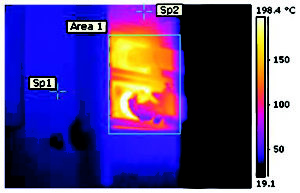Traditionally, insurance companies have taken a reactive approach to property loss resulting from equipment breakdown.
However, in a bid to minimise electrical and mechanical failure and its associated fire risk, an increasing number of insurers are now requiring their customers to adopt thermal imaging to spot electrical and mechanical faults in their infancy.
CNA Insurance has taken this a stage further by offering its customers an IR thermal imaging service.
FLIR thermal imaging has helped CNA to strengthen its risk management programmes and integrate services to protect lives, safeguard assets and increase profitability.
Armed with FLIR IR cameras, CNA’s certified thermographers have conducted 6,445 surveys over the past five years; that’s around 100 surveys per month. They found thousands of faults and deficiencies, averaging 7.3 faults per report. And the company estimates this has saved its thermography customers the equivalent of £10 million per year.
Company statistics showed that average electrical fire losses were around £150,000 for circuit breakers; £390,000 for switchgear and £765,000 for motor control centre (MCC) rooms.
A reasonable average electrical fire loss is estimated to be £575,000. CNA is also able to calculate recovered energy costs using a FLIR software programme that calculates indirect power from surface temperature.
Much of CNA’s survey work, is conducted on FLIR E95 thermal imaging cameras. This Wi-Fi enabled model has intelligent interchangeable lenses, laser-assisted autofocus modes and FLIR’s MSX imaging technology that makes problem diagnosis quick and easy.
A typical example of a customer who has benefited from the FLIR thermal imaging service that CNA Insurance provides is a fruit processing facility, where 14 faults were identified that could have started a fire.
One was critical, three were serious and 10 were intermittent faults. If the problems had remained undetected, the facility would have lost its entire stock due to smoke and fire damage in storage areas containing processed fruit.
This would have represented a loss of around £3 million. And by catching the problems early CNA also saved the customer an estimated £57,000 in electrical repair and energy costs.
 Engineer News Network The ultimate online news and information resource for today’s engineer
Engineer News Network The ultimate online news and information resource for today’s engineer






